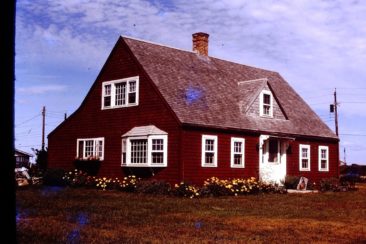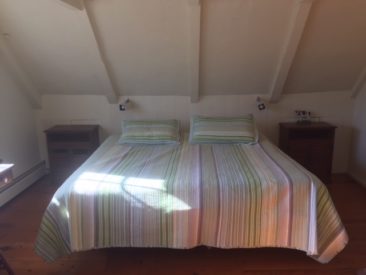Daniel Mott House (1760)

Building Address: 702 Corn Neck Road
Year Erected: 1760
Plat/Lot/Sublot: Plat 3 Lot 33
The Daniel Mott House 1760 has been home to my family since the Massachusetts Bay Colony annihilated the Indians. Their seafaring ancestors inhabited the island 2,500 years prior to the white man’s invasion. The Homestead is located on the corner of Corn Neck and Mansion Roads and was built in 1760. Daniel Mott constructed the original section of the house when he was 18 years old. At this time he was promised in marriage to Mary Dodge. The house he built was half the size that it is now. The ell addition on the left side was the “Milk Room.” Butter, cheese, and ice cream were churned there. Later the Milk Room was converted into a downstairs bedroom. Their children were born in the same birthing room that would become my nursery in 1924. When I inherited the house in 1941 from my parents, furniture was left in the house such as Edward and Waity Rathbone Mott’s table and chairs, they were small people.
Edward Mott (1816-1896) was given the Homestead by his father, Freeman Mott, when he was 37 years old. Edward Mott married Waity Rathbone (1829-1901) in 1860. Edward and Waity’s only son died in 1864, only 1 year, 8 months, and 6 days old. Edward was first and foremost a tiller of the soil. During the Civil War (1861-1865), when in his 40’s, he exported sheep, wool, and agricultural produce to the mainland. Thousands of sheep roamed island pastures. I visualize the Homestead’s farm looking much like the Dutch painter Anton Maure’s 1886 painting “Return of the Flock.”
Edward Mott had three appointments during his lifetime, as keeper of Sandy Point Lighthouse, currently known as the North Light. It is hard to imagine how close the political connections between the federal government’s politicians and Block Island’s leaders were in the mid-1800s. By today’s demographics, the national population was minuscule. In 1841, his first appointment as keeper of Sandy Point was when he was 21 years old. It was a federal appointment by William Henry Harrison’s administration. When Edward was 25 years old in 1845 he was replaced by President James Polk’s crew of keepers. In 1849 he was reappointed when Zachary Taylor came into power. When a third lighthouse was built in 1857, Edward was appointed keeper once more. Three North Lighthouses were built within 28 years, all unstable owing to shifting sands.
In Edward Mott’s early life the island’s main town “center crossroads” was located north of Fresh Pond. The Town Hall was an integral part of the center. In addition to the town’s business it housed a high school complete with a library. The Fourth Baptist Meetinghouse was located there as well. In the 1870’s, when children walked cross-lots to one-room schools, five district classrooms emerged on the island, each serving grades one through eight. Edward Mott donated a portion of his land to this cause. The site was part of the Homestead acreage and given to the town by him. The building, the Neck School, was demolished in the 1940’s. Some of the foundation still remains on property now owned by my daughter, Susan Huggins.
Gladys Steadman, one of the original students, told me of her experiences there:
“We were devils,” she confessed. “During recess we would run over to the Homestead bent on taunting Waity. How we loved to feel our power. Waity would be sitting in her arrowback chair by the parlor window, We would make faces at her, some of us would tap on the small glass panes by her chair. Waity would bang her cane on the wide pine floorboards.
“’Edward git them young’uns back into the schoolyard where they belong. All was peaceful before you gave that land for the school.”
At the Neck School my aunt, Miss Gertrude Mott, taught grades one through eight following her graduation from Normal School in the early 1920’s. The building was torn down in the 1940’s at the request of Alice Ball Barker, who owned the Cottage Farm House across the road. She considered it an eyesore. It was!
Shortly before Christmas in 1886, my grandfather’s Uncle Edward became seriously ill. Prior to his illness, he had been caring for his wife, Waity who had been poorly since the death of their only son, “Little Edward.”
My grandfather, Lorenzo Beckwith Mott, Edward’s favorite nephew, had been helping on the Homestead farm doing what he could for Edward and Waity. Edward was failing fast. It appeared that death was imminent. He worried, “Who will care for Waity? She’s been ‘poorly’ for so long. I always thought she’d go before me.” His mind turned to Lorenzo. During one of my grandfather’s visits Edward poured out his soul. “Lorenzo, I’m worried about what’s going to happen to Waity when I die. Who will care for her? I’ve been wondering if you and Matilda might think about taking her in at the Belle View. I
have no heirs. I’d pass all that is mine to you.”
In 1878, my grandparents, Lorenzo and Matilda Ross Mott they built and opened the Belle View, a mansard roof hotel accommodating sixty guests. My grandparents, Lorenzo and Matilda Ross Mott, were busy bees. Tourism was in its infancy and beginning to replace farming. They were sympathetic, but there was a lot to consider. However, Waity did in fact move into the Belle View from 1896 to 1901.
The inn was located atop High Street commanding views of New and Old Harbors and Crescent Beach. Development centered near the Harbor. The rest of the island remained open space – cleared walls, moved meadows and numerous farms. In the fall of 1880 they suffered a major setback. The Belle View burned to the ground. Not to be deterred, they set to work building a new Belle View. It was a smaller structure accommodating forty guests. They continued to raise meats, fruits and vegetables on their abutting forty acres.
In the Providence Journal on July 6, 1882, “The New Belle View” was described thus: “On the site of the Belle View Hotel, burned in the fall of 1880, Mr. Lorenzo B. Mott has built a hotel 25 by 3 feet, two stories high, with an ell to the south. “On the north end are two parlors, 12 x 13 feet, and south of these a dining room, 16’ feet, wainscoted with hard pine 2’ high.”Besides these rooms the house is divided into kitchen department, halls and stairways, and,twelve bedrooms, averaging 12×15 feet.”The stories average 8’ high. A corridor, five feet wide, extends the whole length of each story, with rooms opening on either side. The house has been very substantially built by A.D. Mitchell, employed by the contractor C.C.Ball. “It has accommodations for thirty people, and has just been opened for the summer.” Later, April 3rd, 1888 Providence Journal, it was reported that Mott had built an addition to the south end of the hotel.
This is where I lived from the summer I turned 8 – my only remembered home until I married Bob Huggins, whose dream was to live on Block Island and update “the Homestead.” He always enjoyed major projects. In this regard, our sons have followed in his footsteps.
For most of his life Edward acted as recorder and clerk for the Baptist Church. August 25, 1857 marked an exciting event in the eyes of most islanders; the Fourth Baptist Church Meetinghouse was dedicated with exuberant fanfare. Guests were brought to the ceremony on the steamer Canonicus. Rowboats brought passengers to shore. The 18-foot Canonicus was built in the year of the Gold Rush, the year of my maternal grandmother’s birth, 1849. That boat burned in 1894.
In February 1896 Edward Matt (80 yrs) was the honored guest at a surprise birthday party at his Homestead on Corn Neck Road; that was destined to become my home in 1924. Edward had not been well for several years. With a choked throat and a tear in his eye, he declared that this surprise made him feel like a young man. I’ve been delving into Edward’s life for so long that I feel more attached to Edward and other island ancestors than I do to current acquaintances. Many were at the birthday surprise.
The birthday party went like this: All sat down to dinner, asking their common Father to bless their food. After dinner, there was a closing prayer and a chorus singing led by my great-great uncle’s wife, Mrs. Hamilton A. Mott. Many were in attendance Edward’s brothers and sister; Hamilton Littlefield Mott and Daniel, Edward’s sister, Mary Ann Mott, who lived across the road from Edward’s Homestead (she was the widow of Hiram D. Ball, Nicholas’s brother), and Edward’s niece was there, Pennella (the widow of Charles Willis). Pennella and her husband were the original builders and owners of the Surf Hotel. They purchased the small cottage at the corner of Water and Dodge streets from Dr. Mann, a Civil War veteran who served as the island’s doctor until his wife had had enough bartering. The couple moved to Massachusetts, where they raised a family, purchased a newspaper and led fulfilling, successful lives. My grandparents were there, Lorenzo and grandmother, Matilda Rose Mott, my grandfather’s brother, Hamilton A. Mott, proprietor of Ocean Cottage (New Shoreham House), which still stands at the corner of Water and Chapel streets,
H. Ansel Ball, with his wife Frances Willis, Lucretia Mott, for whom a stained-glass window was erected at the Harbor Baptist Church. Mrs. J. Eugene Littlefield attended with an “intimate friend”, and the Honorable Nicholas Ball (and his wife), author, statesman, instigator of positive change.
In December, less than a year after the birthday party, Edward, who had a led a “humble, prayerful, and consistent Christian life,” became a spirit in the great unknown. Everyone had been there – relatives and friends; innkeepers and businessmen; and a state senator who would introduce upscale tourism to the island. As a farmer and lighthouse keeper; Mott in many ways represented 19th-century Block Island – industrious, faithful, and determined. The century was about to turn and with it, big changes would be wrought on this tiny agricultural island, which would not be unaffected by the changes on the mainland. The new income tax of 1911, the sinking of the Titanic in 1912, Prohibition, women’s suffrage – all would, in ways large and small, leave their mark on this pork chop-shaped island.
I have many memories of the church on Chapel Street, the Harbor Baptist Church. One of the memories was a Christmas concert in which I wrote a letter to Aunt Gertrude from New London and somebody on the radio pretended as if they were talking to me from the North Pole! The church had pink flowers on Mother’s Day if your mother was alive and
white if she was dead. I had pink flowers but my mother was nowhere to be found. Graduation and baccalaureate were also held at the church. They got the whole day off and picked wildflowers and the teacher decorated the church.
The most dramatic change in the island’s landscape occurred in 1888, eight years prior to Edward’s death; the completion of White Hall which was built near our house, across the field. It was referred to by islanders as Searles’ Mansion. Edward F. Searles was a multi-millionaire, a successful architect and interior designer. He married the widow of Mark Hopkins, builder of the Union Pacific Railroad. At Mark’s demise she inherited $200 million plus extensive real estate. White Hall was occupied by the Searles for less than two months. The dwelling boasted 18 rooms with high ceilings, fireplaces, lavish tapestries and gaudy furniture. The stairs were
marble, imported along with the workers from Italy. It was built in two identical sections – one side for Edward F. Searles and Arthur D. Walker, his personal secretary and companion. The other side was for Mrs. Searles. Mrs. Searles owned a magnificent palace in San Francisco. Together she and Edward owned showplaces throughout the United States as well as several in Europe. Their combined monthly income was estimated to top $100,000.
On the corner of Corn Neck near our house and what is now Mansion Road, Searles opened an “avenue” introduced by brick pillars topped by black marble spheres. These remained in place, minus the finials, until the 1960s, when the view of Old Harbor from Edward Mott’s Homestead was still unobstructed. My family would look for the approaching boat to the east, someone hollering, “It’s time to pick up so-and-so at the ferry!” Mrs. Searles died shortly after the mansion’s construction. Following her death, Edward abandoned this ‘”dream house” and left it to the mercy of the elements. He returned to his estate in Methuen, Massachusetts, and lived the rest of his life with his confidential secretary and companion, Arthur D. Walker. Walker inherited his large holdings.
It was later purchased by Oliver Rose for $2600 and in early July 1923, the mansion opened for the season in a blaze of glory with nearly 200 guests in attendance. From the harbor the scene was beautiful- several hundred electric lights studding the exterior of the massive structure with their bright reflections across the waters of the bay. Lobster and chicken suppers were served throughout the evening while a famous New York orchestra dispensed the harmony for dancing. Fireworks added to the attraction of the evening.
Prosperity boomed for the wealthy. Bobbed hairdos, short beaded dresses, dancing the Charleston, all took place a field away in Oliver Rose’s new mansion nightclub. The strains of “Alice Blue Gown,” “She’s Only a Bird in a Gilded Cage,” “Three O’Clock in the Morning we Danced the Whole Night Through” could be heard all the way to town when the wind cooperated. The Jazz Age was in full swing. The island was a base for rum runners as well as the cutters that chased them. Oliver Rose’s nightclub had no problem obtaining “spirits.”
He, however never did see the end of Prohibition, he died in 1928 at the age of 48. In 1929, the town of New Shoreham took over the mansion for unpaid taxes.
The next owner of the mansion across the field was William P. Lewis, owner of the National Hotel. Lewis and Gladys Steadman were longtime friends and companions, although they never married. They could be seen nightly driving past the Homestead on their way to North Light to observe the sunset. Lewis sold to a group of men from Jefferson, Massachusetts. They catered to summer vacationers, but the
building was in need of repair. It was further damaged in the Hurricane of 1938. Several other owners followed. In 1952 it was purchased by Ernest E. Pollien of Westport, Conn. He intended to develop a community center on the property. That never happened. He paid $57.50 annually in real estate taxes. His caretaker lived in the building in the off season. In February, the caretaker left the island. The mansion burned in April 1963. My husband, Bob, and son William went to fight the fire with buckets. I observed the brilliance of the flames from Homestead window. I never went to fire.
Emily (granddaughter of Alice Huggins) and Chuck Cummiskey bought the Homestead in 2018 from Susan Huggins Sink, Alice’s daughter, the first time that the property had ever been sold.

















Leave a Reply